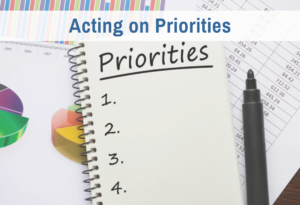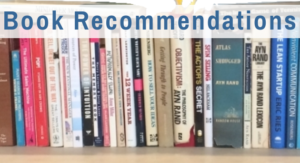Over the years, I have written several articles on how to do a mental cleanup when you need to stop a task prematurely to get started on something else. And I’ve also written about warming up your mental circuits to get started from a cold start.
I reviewed how to stop and start on demand with a Thinking Labber recently, and I realized there was more to be said about transitions. How he was framing the need to make a transition made it harder for him to do it.
I “have to”
As an example of the problem, he mentioned a situation the previous day when he “had to” stop working on a project because he “had to” attend a meeting. This was a problem because he was deep in the middle of interesting work and he had a strong pull to keep going. He felt he had “no choice.”
If you’ve been reading my articles for a while, you know that saying “have to” or “no choice” to me is like waving a red flag at a bull. The truth is that you always have a choice. You may not like your choices, and your boss may not like them, but you always have them. Neither the schedule nor other people nor your past intentions control you.
Just to prove the point, we agreed that five minutes before the meeting, some of his choices included:
- Bow out of the meeting and keep working
- Attend by Zoom but don’t actually pay much attention — keep working on the project and only check in if someone calls for him
- Do his best to save his mental state with a mental cleanup so that after the meeting he could more easily pick up where he left off
- Keep working like a fanatic to try to finish something before the meeting
- Just drop what he was doing to attend the meeting, and pay the penalty in lost context afterwards
The right thing to do in a situation like this is to size up your options and figure out the one that is overall the best for you. That takes stopping to think about your real alternatives.
The mental cleanup (or something like it) is often your best option. That’s why I teach this tactic and include it in The Thinker’s Toolkit!
Why you don’t think of the better option that you know
The Thinking Labber knew all about the mental cleanup tactic. He told me that every time he had used it, he had found it helpful. So why didn’t it occur to him the other day? Because he was framing the problem as “I have no choice.”
The problem here is not just that this assumption is false. In addition, saying “I have no choice” sets up tunnel vision. If you believe that you have no choice, then you will not look for other choices. If he had asked himself what his options were for dealing with the conflict, he might very well have remembered the mental cleanup tactic. But when you have an explicit assumption, only thoughts consistent with that assumption will occur to you.
Moreover, a situation like this (“I have to” and “I have no choice” about stopping this interesting work) automatically triggers threat-oriented emotions. You feel an aversion to stopping. You might be angry that you don’t have more autonomy over your schedule. You might feel guilt or frustration that you didn’t finish the task you started as quickly as you expected — because when you started you thought you’d be finished by now.
As I’ve said elsewhere, threat-oriented emotions drag your attention to threats and away from the values at stake. Notice that these kinds of feelings actually interefere with using your last five minutes to do something constructive before the meeting starts. If you focus on these feelings, they make you feel like a victim and distract you from more useful responses. If you try to tune them out, you feel a lot of pressure, which reinforces the tunnel vision and prevents you from coming up with creative solutions in that last five minutes.
What I recommend
This is why I recommend that you always monitor for threat-oriented emotions. The second you start feeling pressure, or resentment, or aversion, it’s time to introspect and re-orient to values. This is not a hard process but it is never automatic. What is automatic is the triggering of the threat-oriented emotions.
Another option is to set up some standing orders to catch known falsehoods like “no choice” and “have to.” These thoughts undercut your ability to think creatively about difficult situations every time. Every time! Creativity comes from seeing the world in terms of values you want to gain and seeing the threats as just some obstacles making certain paths more difficult than others. Once you see threats as relative to the values threatened, you will also see that there are multiple ways to gain any particular value. You can pick the one that is easiest and safest. If the value is highly important, that easiest and safest way may be difficult and risky, but it’s worth it to you because you know the value to be gained.
It used to be popular to say emotions hijacked your attention. That’s a little dramatic. But it is true that you can’t control whether an emotion is triggered. And if the emotion is triggered, it will draw your attention to its object. For threat-oriented emotions like fear, anger, guilt, frustration, and aversion, the object is a threat, not a value.
Thus, every person on earth will need to intervene from time to time when they get pulled into a threat orientation. The solution is to monitor for that eventuality and learn tools to get back to being value-oriented — where you are creative.
“I need a break”
Ironically, after that meeting, the Thinking Labber didn’t feel like going back to the project he had been so loath to stop. He reported that he felt he needed a break. Here, too, the way he naturally thought about the situation got in the way of his doing what was best for him.
The problem with “I need a break” is not that it’s false. It could be that you do need a break. We often need a transition between very different tasks. For example, maybe the meeting was a little heated, and you want to get emotionally grounded. Or maybe you’re a bit tired from concentrating, and you need to re-energize. Or maybe you’re hungry, and you were able to put that feeling aside, but now it’s getting urgent and you need to eat something so you won’t be distracted during the next time period.
The problem with the words “I need a break” is that they focus you only on stopping — not on starting up again.
How often have you started a short break that lasted much longer than you intended? You can lose a lot of momentum and productivity if your 10-minute break lasts 30 minutes or more.
This, too, is a predictable problem. I’ve had this problem with taking a 10-minute fiction break. I get involved in the story and lose track of time. Perhaps you’ve had the problem with chatting with someone. Somehow your quick hello turns into a long conversation. Once you are doing a certain kind of activity, inertia leads to continuing the same activity until you reach some natural stopping place. All the while, the next task on the agenda gets farther and farther out of mind.
In general, you need to keep your purpose in mind when you take a break.
But in particular, if the words “I need a break” occur to you, it would be helpful to set a standing order to frame the situation in terms that will help you get started on the next task in a timely way. What you usually want is a re-energizing transition, not a break per se.
Some productive ways to take a break so that you naturally transition to the next task
My favorite way to take a break is with a 3-minute walk. You may have seen my video about this. A 3-minute walk is time-limited and energizing. Moreover, I spontaneously use it to think about the situation a little bit and set my purpose. I am ready to roll when I get back to my desk.
Another great way to take a limited break is to quickly tidy the desk. When I tidy my desk, I remember all of the projects that I am working on, and as I organize the papers on my desk, I spontaneously start thinking about my priorities. Because I tidy my desk reasonably frequently, it never takes very long. When I’m finished, I always have some work front and center, and I have slightly warmed up the context. Like the 3-minute walk, a quick tidy has a definite end point and also leaves me some crow space for percolating on what comes next.
My colleague, Lin Zinser, says she sets a timer to keep a break short. That works great for her. I sometimes find I need more than just an alarm to get me focused on the next task. For example, I recently put my timer in the next room with the material I needed to work on. This guaranteed that to stop the noise, I literally needed to get up and look at those materials.
I’m sure there are many other ways of ensuring that a break moves you closer to getting started again. The key is — think of it as needing a transition, not a break. Framing it as a transition incorporates both the need to stop and the need to get started again.
The bottom line: The specific words you use to describe your next steps can affect whether good options occur to you and whether you put yourself on track to achieve your goals, maximizing both ease and productivity.









0 Comments